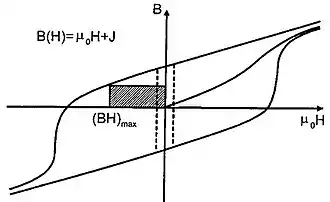Maximum energy product
In magnetics, the maximum energy product is an important figure-of-merit for the strength of a permanent magnet material. It is often denoted (BH)max and is typically given in units of either kJ/m3 (kilojoules per cubic meter, in SI electromagnetism) or MGOe (mega-gauss-oersted, in gaussian electromagnetism).[1][2] 1 MGOe is equivalent to 7.958 kJ/m3.[3]

During the 20th century, the maximum energy product of commercially available magnetic materials rose from around 1 MGOe (e.g. in KS Steel) to over 50 MGOe (in neodymium magnets).[4] Other important permanent magnet properties include the remanence (Br) and coercivity (Hc); these quantities are also determined from the saturation loop and are related to the maximum energy product, though not directly.
Definition and significance

The maximum energy product is defined based on the magnetic hysteresis saturation loop (B-H curve), in the demagnetizing portion where the B and H fields are in opposition. It is defined as the maximal value of the product of B and H along this curve (actually, the maximum of the negative of the product, −BH, since they have opposing signs):
Equivalently, it can be graphically defined as the area of the largest rectangle that can be drawn between the origin and the saturation demagnetization B-H curve (see figure).
The significance of (BH)max can be illustrated by considering a simple magnetic circuit containing a permanent magnet of volume Volmag and an air gap of volume Volgap. The total magnetic energy in the gap (volume-integrated magnetic energy density) is then directly related to the volume-integrated −BH in the magnet:[5]
thus in order to achieve a particular magnetic field Bgap in the gap, the required volume of magnet can be minimized by maximizing −BH in the magnet (by choosing a material with high (BH)max, and operating it at the (BH)max point by matching the magnet geometry to the circuit's reluctance).
References
- "What is Maximum Energy Product / BHmax and How Does It Correspond to Magnet Grade? | Dura Magnetics USA". Retrieved 2020-01-20.
- "Glossary of Magnet Terminology". K&J Magnetics. Retrieved 2021-01-31.
- eFunda: Glossary: Units: Energy Density Units: Megagauss-Oersted (MG⋅Oe)
- "COBALT: Essential to High Performance Magnetics" (PDF). Arnold Magnetic Technologies. 2012.
- Fitzgerald, A.E.; Kingsley, Charles, Jr.; Umans, Stephen D. (2003). Electric Machinery (6th ed.). McGraw-Hill. p. 34-. ISBN 978-0-07-366009-7.